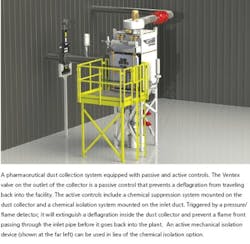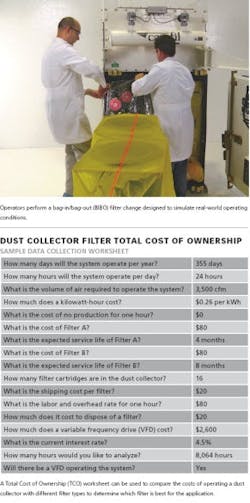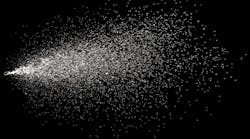Contained dust collection equipment is used in pharmaceutical facilities for a variety of reasons, from environmental compliance and employee health and safety to preventing cross-contamination of materials in multi-product manufacturing facilities. Given these concerns, and the fact that many pharmaceutical dusts are potent and/or hazardous, contained dust collection systems are found in the majority of pharmaceutical processing facilities today. Such systems typically utilize safe-change containment for both the filter cartridges (bag-in/bag-out) and the discharge system underneath the collector (continuous liner technology).
The following are five important tips for designing and selecting a contained dust collection system – pointers that should give pharmaceutical professionals a general overview of the process to make sure all bases are covered when approaching dust collection system design.
1) Conduct a risk assessment to identify and prioritize goals.
The dust collector must often satisfy many masters with varied agendas. The NFPA is concerned with explosion protection, the FDA with delivering safe products to consumers, OSHA with indoor environmental and safety issues, and the EPA with outdoor air quality. The pharmaceutical facility is tasked with satisfying all these entities while also meeting internal goals of product quality, operational efficiency and cost control.
What are the expectations for the dust collection system? A risk assessment is needed to help identify safety and performance goals for the dust collector and how to achieve them. It is best to involve a professional engineer who can commission appropriate explosibility testing, bench testing to determine other properties and characteristics of the dust, and surrogate testing as appropriate to determine appropriate system design.
2) Consider surrogate testing.
Used as part of the risk assessment, surrogate testing can provide useful performance information prior to installation, to help determine if the planned dust collection system will meet environmental and safety goals. Surrogate testing involves the use of a substitute or surrogate compound to simulate an API and predict real-world performance. Test conditions should mimic workplace operations as closely as possible without incurring the expense or health concerns of handling the API.
In a typical test, the surrogate dust is fed to the collection system on a pre-determined schedule. Operators equipped with air sampling devices perform bag-in/bag-out filter change-outs and contained discharge system clean-outs under conditions that simulate shift-equivalent operations. A combination of air, surface wipe and personal samples are taken at specified intervals during the test period to evaluate performance.
If samples are found to be below established thresholds, the manufacturer will accept the surrogate test as evidence that the contained dust collection system as designed can be expected to provide the required level of emission control performance under real-world operating conditions. By validating equipment performance during the engineering phases, it is thereby possible to reduce costs while ensuring proper equipment design and selection.
3) Incorporate a Risk-MaPP approach to cross-contamination control.
Cross-contamination is a major concern that can result in a facility shutdown by the FDA. For multi-product facilities concerned with preventing this occurrence, Risk-MaPP (“Risk-Based Manufacture of Pharmaceutical Products”) provides a useful guide to managing risk. Introduced in 2010, this ISPE baseline guide provides a scientific approach to managing cross-contamination in new and renovated facilities that are tasked with complying with FDA requirements. One of the main goals of Risk-MaPP is to achieve a balance between product quality, operator safety and manufacturing costs.
There are several ways that cross-contamination occurs. These include airborne transfer¸ the airborne migration of particulate contaminants from one manufacturing space to another; and mechanical transfer, which occurs when particulate is carried from one processing area to another on the shoes or clothing of operators and/or via equipment that is utilized in more than one location. A contained dust collector can address both problems by capturing airborne particles while simultaneously minimizing the build-up of surface dust that can be transferred mechanically from one place to another.
How does a facility ensure that Product A is not contaminating Product B? Sampling is critical and should include both surface sampling and airborne concentrations. We addressed the topic of surrogate testing and sampling in section 2 above, but with a focus on environment, health and safety. When we look at cross-contamination testing, the methodology is similar but the end goal is product quality rather than operator safety. It is important not to confuse the two: I.e., be cautious about using industrial hygiene data for cross-contamination purposes. The two goals are different, and the quality thresholds of one program may be more – or less – strict than the other.
Surrogate testing can help with quality control programs by providing real-world test results to the FDA that indicate how the planned engineering controls will be expected to perform. Testing and sampling can also help pharmaceutical manufacturers to identify the most cost-efficient equipment for a given application. Some engineering controls relating to dust collection can add significant cost to a project. There is a balancing act between what will work and what will be economically feasible, and a scientific test-based approach will be far more accurate than guesswork in striking the right balance.
An active system, by contrast, actually prevents an explosion from occurring. It may be the system of choice if the collector is located inside the manufacturing facility or if the unit is collecting hazardous or potent material that cannot be released directly to the outside environment. An active system involves much more costly technology and typically requires re-certification every three months.
One example is a chemical isolation system, which can be installed in inlet and/or outlet ducting. It reacts within milliseconds of detecting an explosion, creating a chemical barrier that suppresses the explosion within the ducting. A chemical suppression system is similar in concept, except it is designed to protect the dust collector itself as opposed to the ducting. Sometimes used in tandem with isolation, a chemical suppression system detects an explosion hazard and releases a chemical agent to extinguish the flame before an explosion can occur.
Published in the December 2013 edition of Pharmaceutical Manufacturing magazine
David Steil is pharmaceutical market manager at Camfil Air Pollution Control (APC), where his responsibilities include global sales and marketing to the pharmaceutical/nutraceutical industries. He previously spent 12 years with a major pharmaceutical company in the corporate Environment, Health and Safety group. Steil is a member of the International Society for Pharmaceutical Engineering (ISPE) and the American Industrial Hygiene Association (AIHA).









